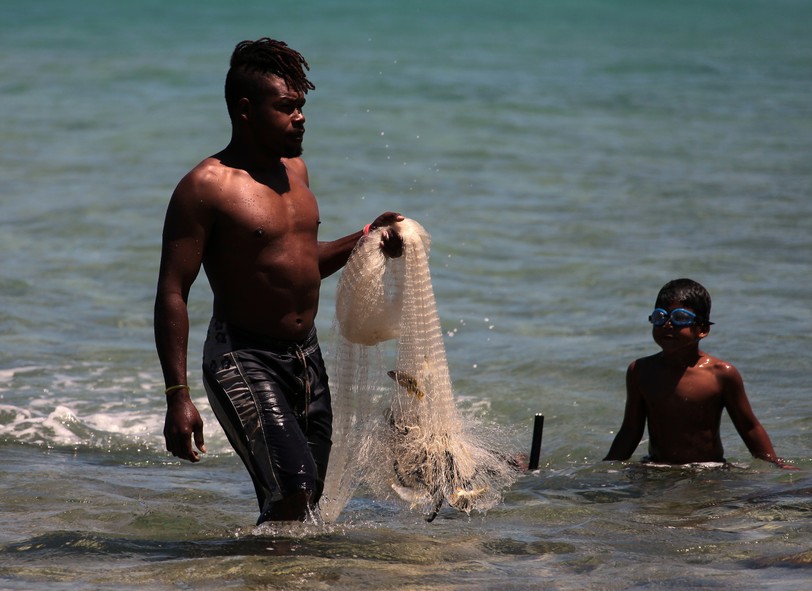PECHEUR A L'EPERVIER
Lien vers des images sur les poissons de Nouvelle-Calédonie (ici)
L'épervier est un filet qui se lance à la main. Il est de forme conique. C'est un filet prêt à pêcher. Il est fortement plombé à la base. La bordure est relevée pour former une bourse (poche) de 20 cm de haut. Il est muni au centre d'une corde de jet de 4 à 7 m de long selon le nombre de mailles à la base. La pêche à l'épervier se pratique la plupart du temps dans des eaux peu profondes. Le pêcheur ne doit pas porter de vêtements à boutons afin de ne pas être entraîné à l'eau par l'épervier.
Mode d'emploi de l'épervier :
- Est lancé depuis la berge ou d'un bateau.
- Se déploie en rond dans l'eau.
- Doit être parfaitement ouvert en retombant dans l'eau.
- Se relève en tirant sur la corde de jet.
- Se referme et englobe les poissons en le relevant.
- Piège le poisson dans les bourses (poches).
---------------------------------------------
Link to New Caledonian fish species (here)
Throw nets are used to capture live bait for fishing. They are also referred to as cast nets. The net is circular, and weighted at the bottom with lead weights. When the net is thrown, it opens and sinks around the baitfish, trapping them in the net. The net operator then retrieves the net using the rope tied to the center. With the proper technique and some practice, you can use a throw net to cover a wide area.
Instructions to use
- 1 Select the correct-size net. The length of the net is measured with the net hanging downward. A 10-foot net will have a diameter of 20 feet. Larger nets are heavy and unwieldy to throw, so it's best to start out with a smaller net. Work your way up in size as you gain experience and get better at net throwing.
- 2 Select a quality net. A good net will have at least one pound of weight per foot of length. The net filament should be durable but not so thick that it slows the sinking rate of the net. Choose a net with a mesh size that is appropriate for the type of baitfish you will be catching.
- 3 Remove any wrist jewelry such as bracelets or watches before you throw the net. The rope is attached to the wrist, and it's possible for them to come off when the net is thrown.
- 4 Insert the rope through the loop at the end, then slip the loop over the wrist on your dominant hand.
- 5 Coil the rope in loose loops, holding the loops in the hand attached to the rope with your palm up.
- 6 Make a circle over the rope with your thumb and forefinger of your free hand, then pull the net through the circle.
- 7 Grasp the top of the net with the hand holding the rope. Gather up the net until you can position the hand holding the net at waist level with the line holding the lead weights dangling near your feet.
- 8 Pick up the bottom of the net with your free hand, then gently bite the net mesh close to the lead line.
- 9 Grab the lead line with your free hand, and flick your hand so the lead line slides through. You should grasp the lead line at a point where half the weight is in your free hand, and half the weight is held by the hand holding the rope.
- 10 Swing your upper body around so that your shoulder is pointing at the location you wish to throw the net. Allow the momentum of the net to carry the weights behind you, then swing your body back around while extending your arms.
- 11 Release the net from your hands and teeth as soon as you feel tension on the net. The net should land fully open.
